TABLE OF CONTENTS
Sufficient cooling is incredibly crucial for your CPU’s performance.
In the short term, it allows the CPU to increase its clock speeds dramatically and gives it a much better chance at reaching those advertised boost clocks. However, in the long term (passive work), it ensures that a particularly lengthy render won’t get prolonged due to thermal throttling.
But what is the best way to cool your CPU?
On the one hand, you have air – also known as HSF (HeatSink & Fan) – coolers that are inexpensive, easy to install, and offer excellent cooling performance.
On the other, you’ll find powerful liquid AIO coolers that take up far less space in your case and allow for some incredibly stylish setups.
So, which one is the right choice?
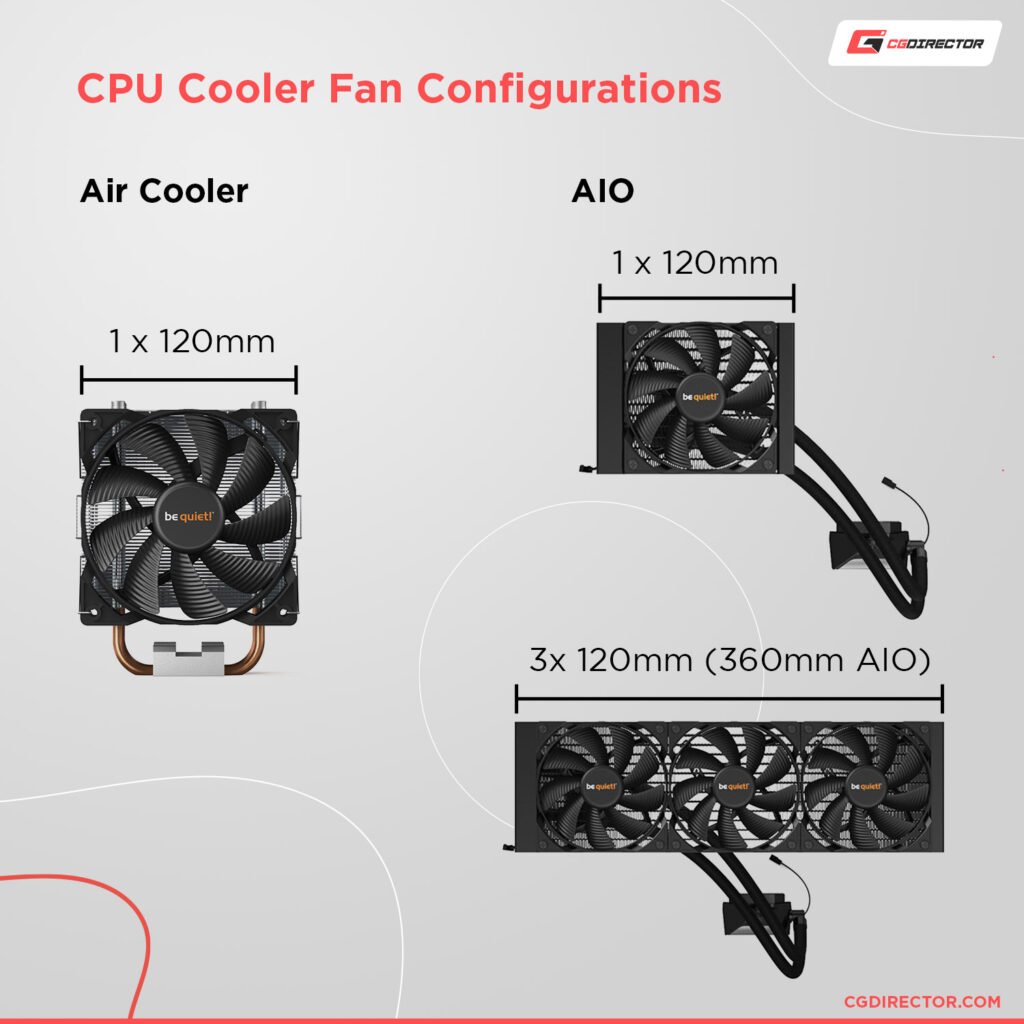
The answer ultimately depends on your setup, preferences, and the workloads you hope to support.
We’ll first look at what these two cooling methods consist of, what sets them apart, and which one is best for different setups, budgets, and even aesthetic inclinations.
What are CPU Coolers, and Why Are They Needed?
Before we get into the differences between AIOs and Air Coolers, let’s go over the basics of what CPU coolers are and why they’re necessary.
What is a CPU Cooler?
Electronic components are never 100% efficient, and this is especially true for PC Hardware like CPUs.
A chunk of electricity enters the CPU, but all of it isn’t ‘used.’ Some of it is wasted and gets converted to heat. It’s this heat that you have to draw out and dissipate effectively, failing which the processor throttles and underperforms, and in some extreme cases, gets permanently damaged.
A CPU cooler is specifically designed for this task: drawing excessive heat from the CPU, spreading it through a heat-conductive medium, and transferring it away from the cooler so your case’s airflow can transport it out.
Stock CPU Coolers
Some CPUs come with a stock CPU cooler included (both AMD and Intel).
However, their stock coolers range from being reasonably passable to being noisy and near-useless for intensive workloads.
They usually include a single fan, a small heatsink, and no heat pipes for effective heat transfer.
The only exceptions to this are AMD’s Wraith Prism and Wraith Max coolers, which used to be included with the Ryzen 3000 series CPUs.
Unfortunately, that’s not the case anymore. AMD Ryzen 5000 series and Intel 11th generation CPUs now only come with a pretty disappointing stock cooler (the Intel one is still worse) with entry-level processors.
Why Investing in premium Cooling Is Always Important
Parts like processors, graphics cards, motherboards, etc., come and go – especially if you’re a PC enthusiast.
Sure, your PC can last you 4-5 years and still be adequate, but there will come a time to upgrade.
And one of the few components that can transfer over to a new build is the cooling equipment, like the case-fans and the CPU cooler.
At first, investing in premium cooling may seem like a waste since you could allocate that part of the budget towards buying components that more directly increase performance, but it could well be worth the extra cost in the long run.
Not only do you get more increased performance from your CPU, but you also get a component that can theoretically last upwards of 150,000 hours (=17 years of 24/7 operation, at least for Air Coolers).
That said, compatibility can still be a challenge if a CPU manufacturer decides to opt for a new socket that isn’t directly compatible with older cooling solutions.
However, CPU cooler manufacturers (especially premium ones like Noctua, beQuiet!, Cooler Master, Corsair, etc.) have historically accommodated these new sockets with a new bracket for compatibility. Hence, most companies ship it to existing customers for free when requested; others might charge a relatively nominal fee.
What Are HSF CPU Coolers?
Air CPU coolers use a cold plate made of copper or aluminum to remove heat from the surface of the CPU’s IHS (Integrated Heat Spreader) through the thermal paste.
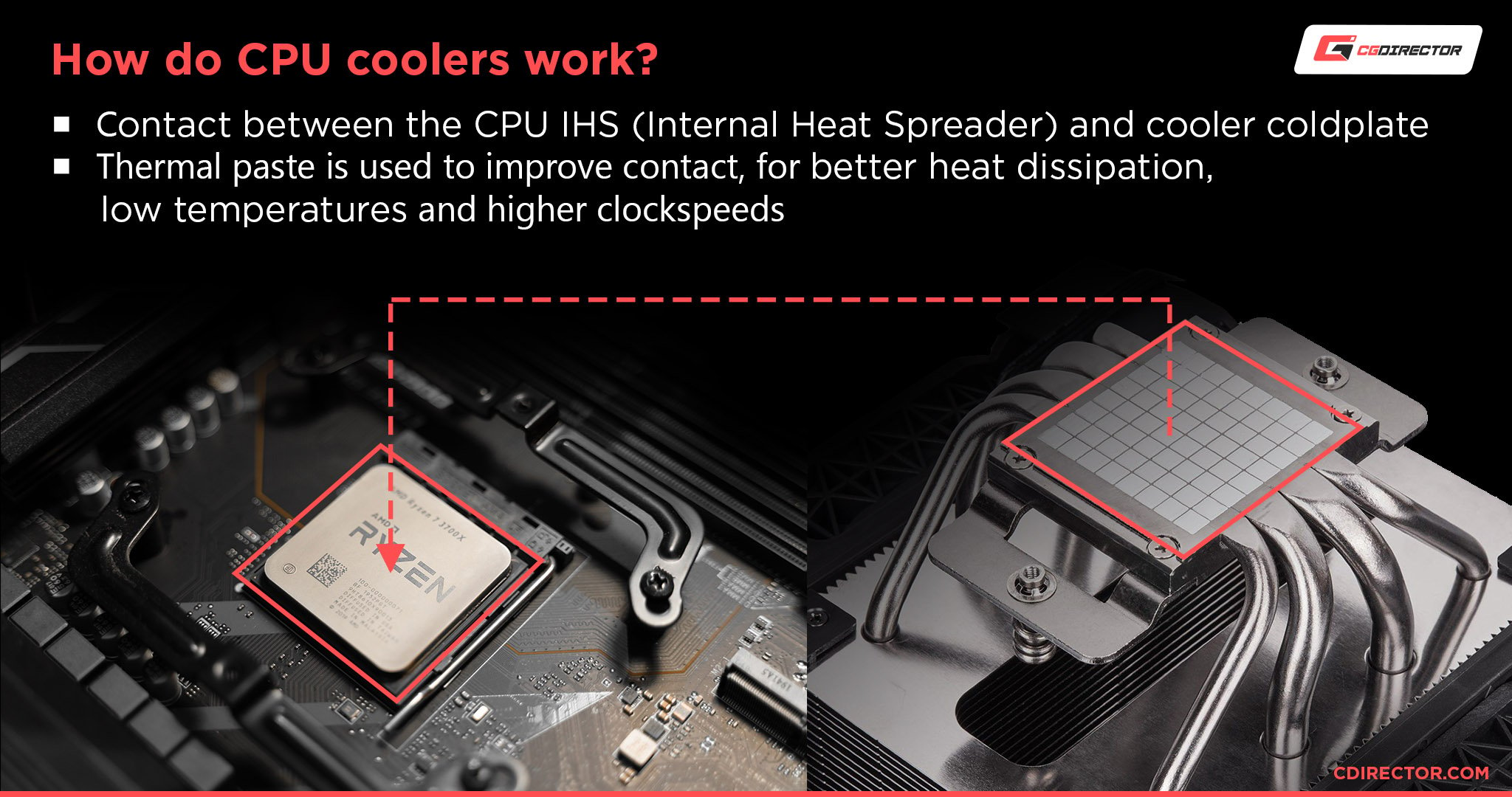
This heat is then transferred to the heatsink, usually made of aluminum fins to maximize surface area.
Heat transfer can either be done using direct contact or using heatpipes.
The heatpipes contact the cold plate (or even directly with the CPU) and contain a liquid coolant (distilled water, ammonia, and others). This liquid coolant becomes gaseous when heated, causing it to move upwards through the heatpipes, where they make contact with the fin stack array along the way.
When the coolant reaches the top, it cools, condenses, and then drips down the heat pipe to be heated again.
The heatsink is cooled by one or two cooling fans, which either push, pull, or push & pull (two fans) any hot air that permeates between the fin stacks.
This process effectively chills the heatsink so that it can absorb additional heat and repeat the process.
Existing airflow within the PC’s case should then transport this hot air out of the case’s rear exhaust to be replaced by cool air from its front intake.
Different Types of Air CPU Coolers
There are four main types of HSF CPU coolers:
- Vertical tower CPU coolers (U-type), like the NH-U12S.
- Dual vertical tower CPU coolers (D-type), like the Scythe Fuma 2.
- Top flow CPU coolers with a horizontally aligned tower (C-Type), like the Cryorig C1.
- Low profile CPU coolers (L-Type or LP), like the be quiet! Shadow Rock LP.
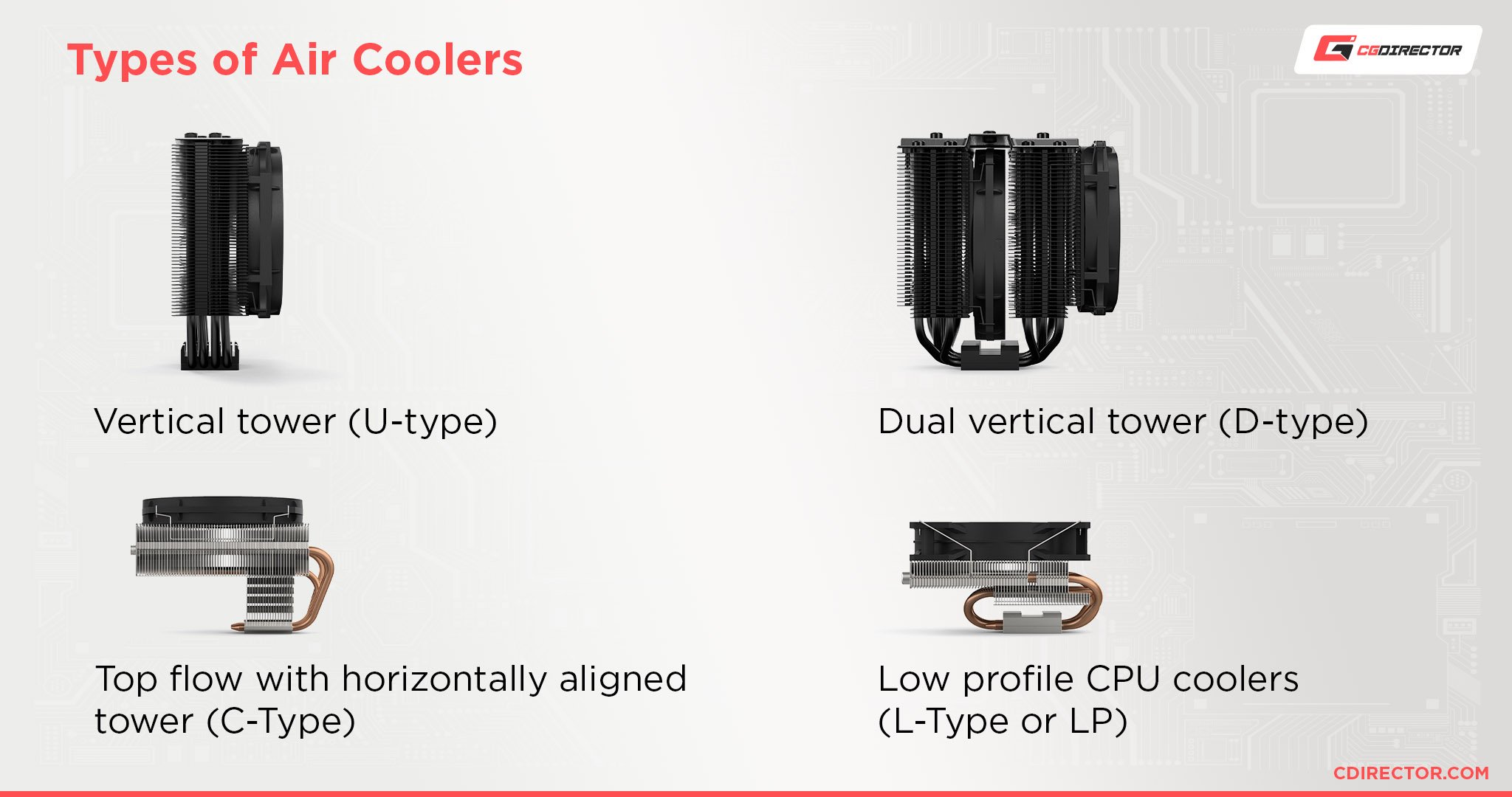
Advantages
Price
The most significant advantage of an air cooler is its price. You’ll find some of the best CPU coolers on the market for under $100.
Keep in mind: these are coolers that can keep even the most power-hungry, high-core-count CPUs from being throttled too heavily when overclocked and running heavy workloads.
Versatility & Ease of Use
HSF coolers are easy to install and come with various brackets that can fit into corresponding sockets from AMD’s and Intel’s Line-up of CPUs for Desktop and Servers. That said, some PC builders find it easier to work with AIO liquid coolers than Air coolers, so this one kind of boils down to personal preference.
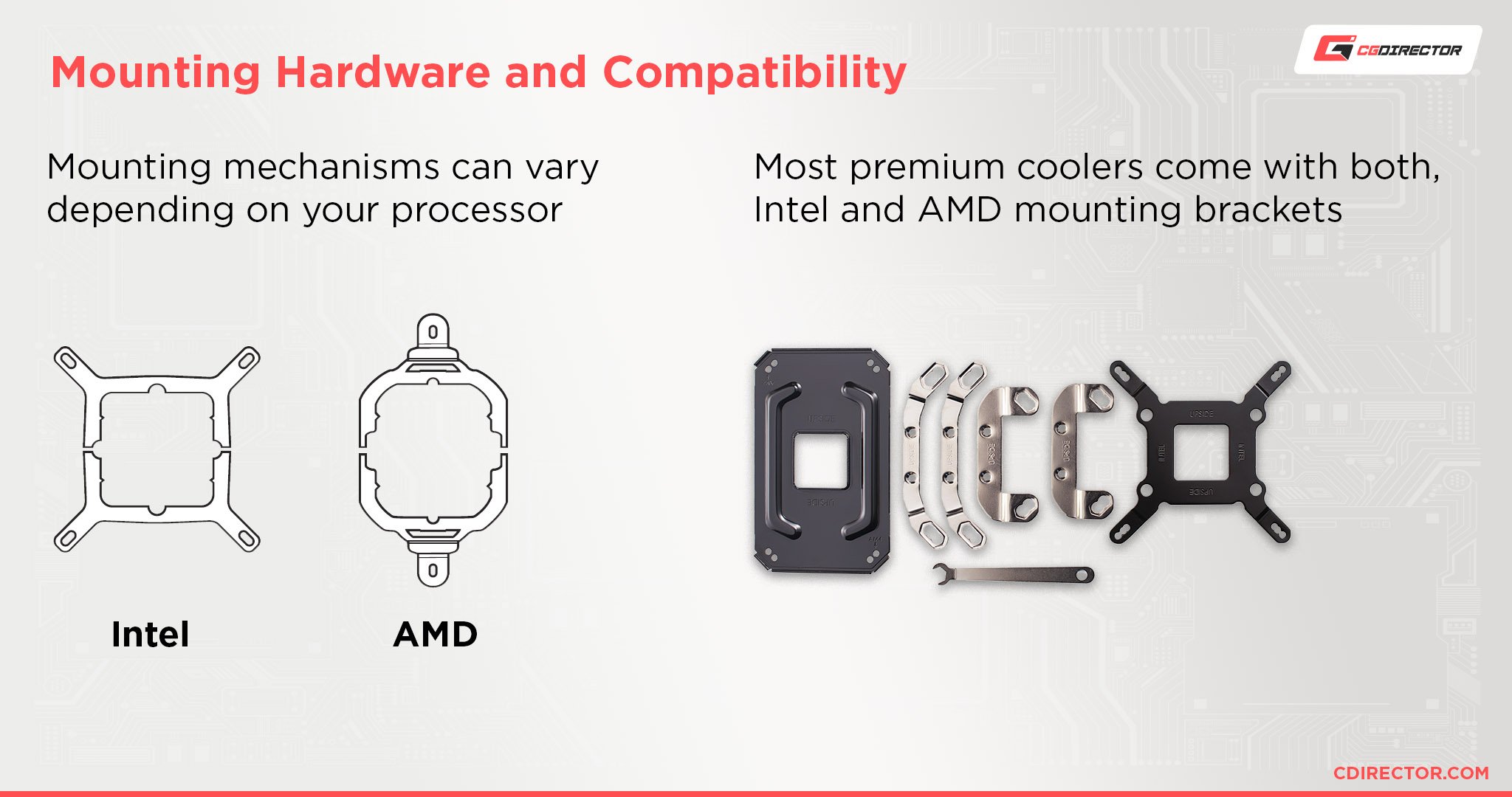
You can usually re-use HSF coolers across PC builds, even if your next CPU is of a different brand, as long as a compatible bracket is available.
Noise Emissions
Because air CPU coolers often rely on a single fan to push air through a large heatsink, the fan itself might have to spin at high RPM (Rotations Per Minute), which makes some cheaper air coolers quite noisy.
However, with the introduction of higher quality fan bearings – like FDB (Fluid Dynamic Bearings) and Self-Stabilising Oil-pressure (SSO) systems – most quality air coolers shouldn’t exceed the 40 dB mark.
In fact, high-end models – like the NH-D15 – only reach noise levels that range from just 24 dB (at 7.5V supplied) to 35 dB (at 12V).
This means that the noise they produce will either be inaudible or around the sound level of light whispering.
Upgrade Potential
Another advantage of the HSF CPU cooler is its potential for upgrades.
Let’s say you buy an NH-U14S, for example, which comes with a single NF-A15 fan.
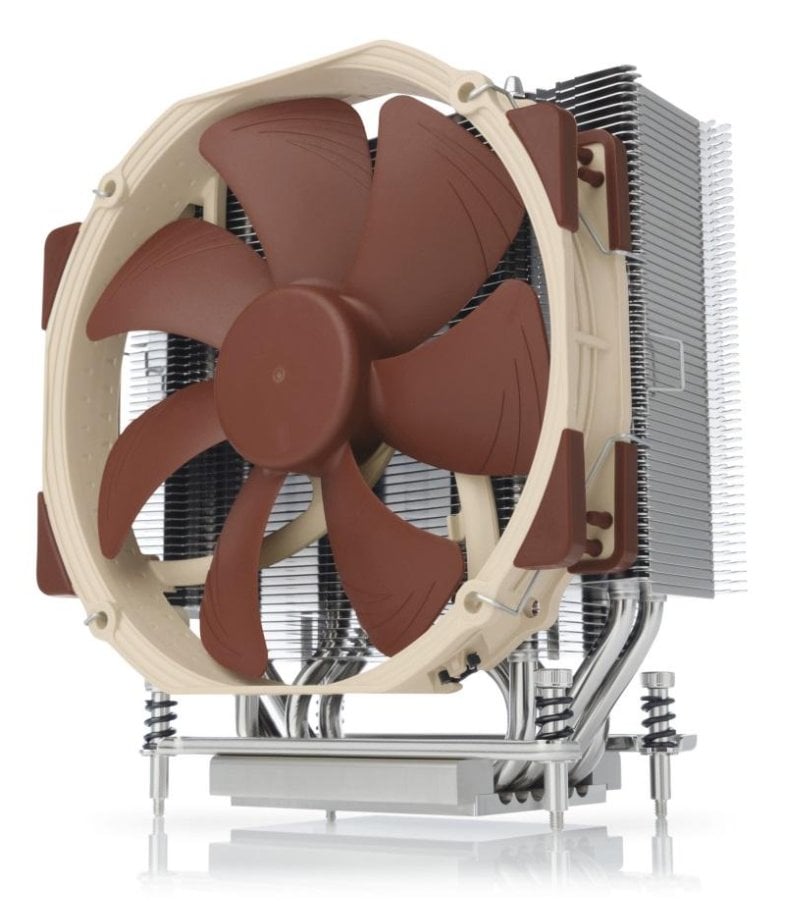
Image-Source: Noctua
If you see that the thermals of the CPU are reaching levels higher than you’d like, you can simply add a second NF-A15 fan to your setup (given that you have the clearance) and instantly upgrade cooling performance without a lot of tinkering.
You can even upgrade low-profile CPU coolers like the Scythe Big Shuriken 3 by swapping its slim fan for a thicker, higher-performance case fan like the NF-A12x25.
The difference in cooling performance with this upgrade is quite impressive for a low-profile air cooler.
Disadvantages
Space Restrictions
The universal downside of all full-sized air coolers is that they are bulky and take up too much space around the CPU. In fact, some large air coolers can nearly cover the entire top half of your motherboard.
Blocking too much of the top of your case can impede internal airflow, cause clearance issues with RAM, or even cover the motherboard’s top PCIe slot where you’d want to install a graphics card.
The good news is that you can avoid most of these issues with a bit of research.
Use the CPU cooler’s compatibility sheet that the manufacturer usually provides to confirm compatibility with the parts you’re picking.
For example, Noctua allows you to find the exact PC case, CPU, and motherboard you have and confirm which Noctua CPU coolers are compatible with them.
Thermal Headroom
HSF CPU coolers are very simple in their construction as they only have one mechanically moving part: the fan(s).
But because the liquid within the heatpipes cannot be recycled nearly as fast as that in an AIO liquid cooler, there is a limit to how much cooling can be supplied to the CPU for extended periods of time.
Only the top echelon of CPU air coolers (which tend to be relatively large) can keep a processor cool during sustained workloads or when manually overclocked.
What Are Liquid AIO Coolers (Closed Loop Coolers)?
Like HSF coolers, Liquid AIO (All-in-One) coolers also use a baseplate (usually made of copper) that comes in contact with the CPU via the thermal paste.
The baseplate transfers the heat to a liquid (usually distilled water with propylene glycol) when it is heated. This liquid is then continuously pumped through a tube towards a radiator that’s separated into two halves: top and bottom.
Passing through the radiator allows the heat from the liquid to transfer to its aluminum fins, which are chilled by cooling fans.
After the liquid passes through the top half of the radiator, it makes a U-turn and passes through the bottom half of the radiator. This way, the coolant gets a chance to cool for a longer duration.
When it completes this cooling process, it’s then pumped back towards the baseplate through a separate secondary tube to complete its cycle.
For a more detailed look at the process with 3D animations, make sure to check out Gamer’s Nexus’s technical deep dive video on the subject.
Different Types of AIO CPU Coolers
Liquid AIO CPU coolers may have several minor variations between one another (like the pump, the tubing, the base plate design, etc.). Still, the main differences between them are their sizes.
Their size will also determine how many fans will be mounted on the radiator and how massive the radiator is, which also tells us a lot about its cooling capacity.
These fans are usually 120 or 140 millimeters in diameter and between one and three in number.
Hence, you can have four main categories of radiator types:
- Single fan (120-140 mm radiator), like the Corsair iCUE H60i.
- Double fan (240-280 mm radiator), like the NZXT Kraken X63.
- Triple fan (360-420 mm radiator), like the Arctic Liquid Freezer II 420.
- Compact AIO CPU Cooler (single 92 mm fan), like the Cooler Master MasterLiquid Maker 92.
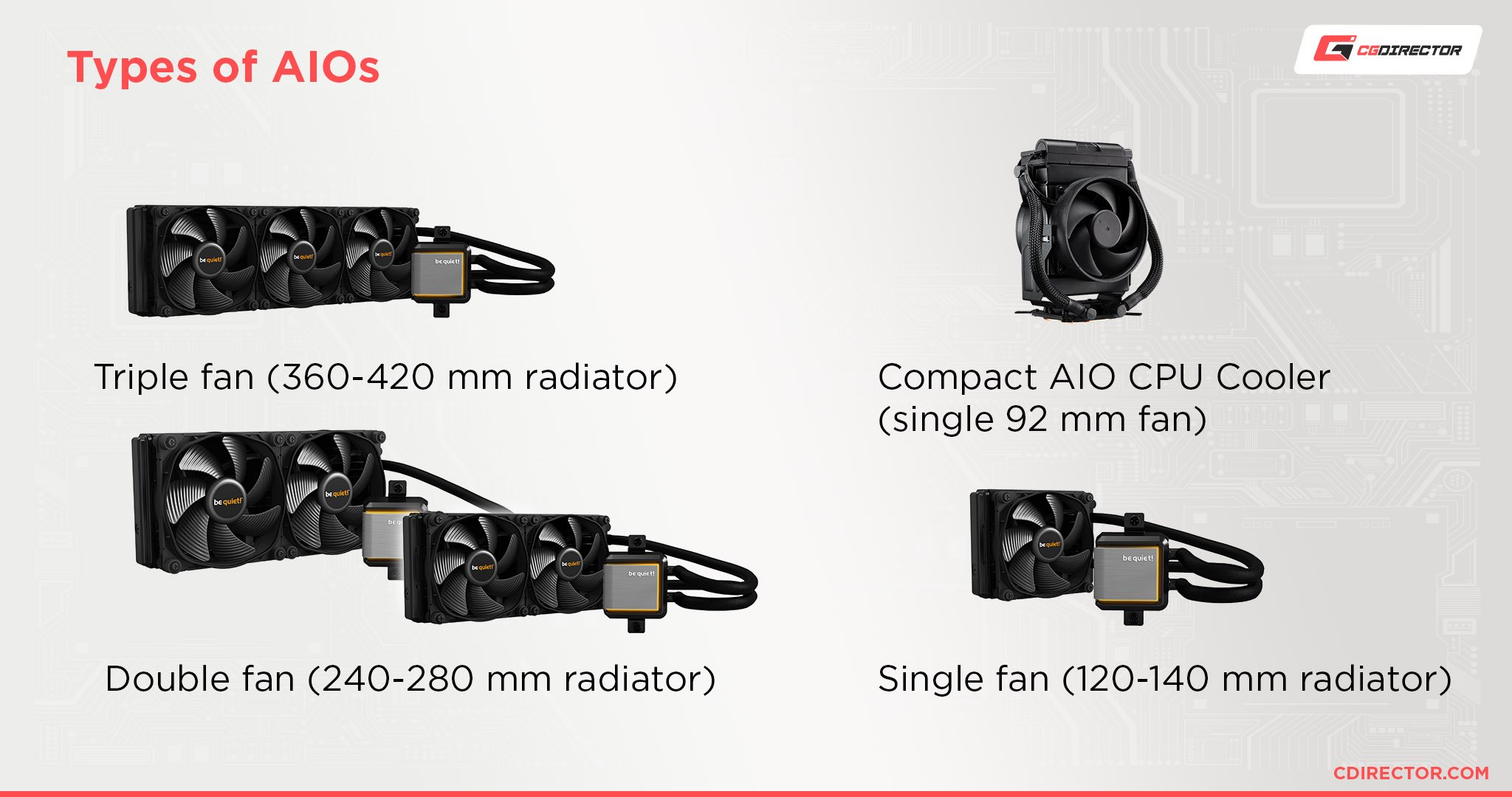
Advantages
Thermal Headroom
In contrast to HSF CPU coolers, the main advantage of their AIO counterparts is how much thermal headroom they allow for the CPU.
Not only does the liquid coolant take longer to heat up, but you also have a reservoir of relatively cool liquid ready to take its place.
This allows the AIO cooler to sustain lower CPU temperatures for extended periods.
Clutter-Free
Another considerable advantage of liquid AIO coolers is that they don’t take up too much space around the CPU.
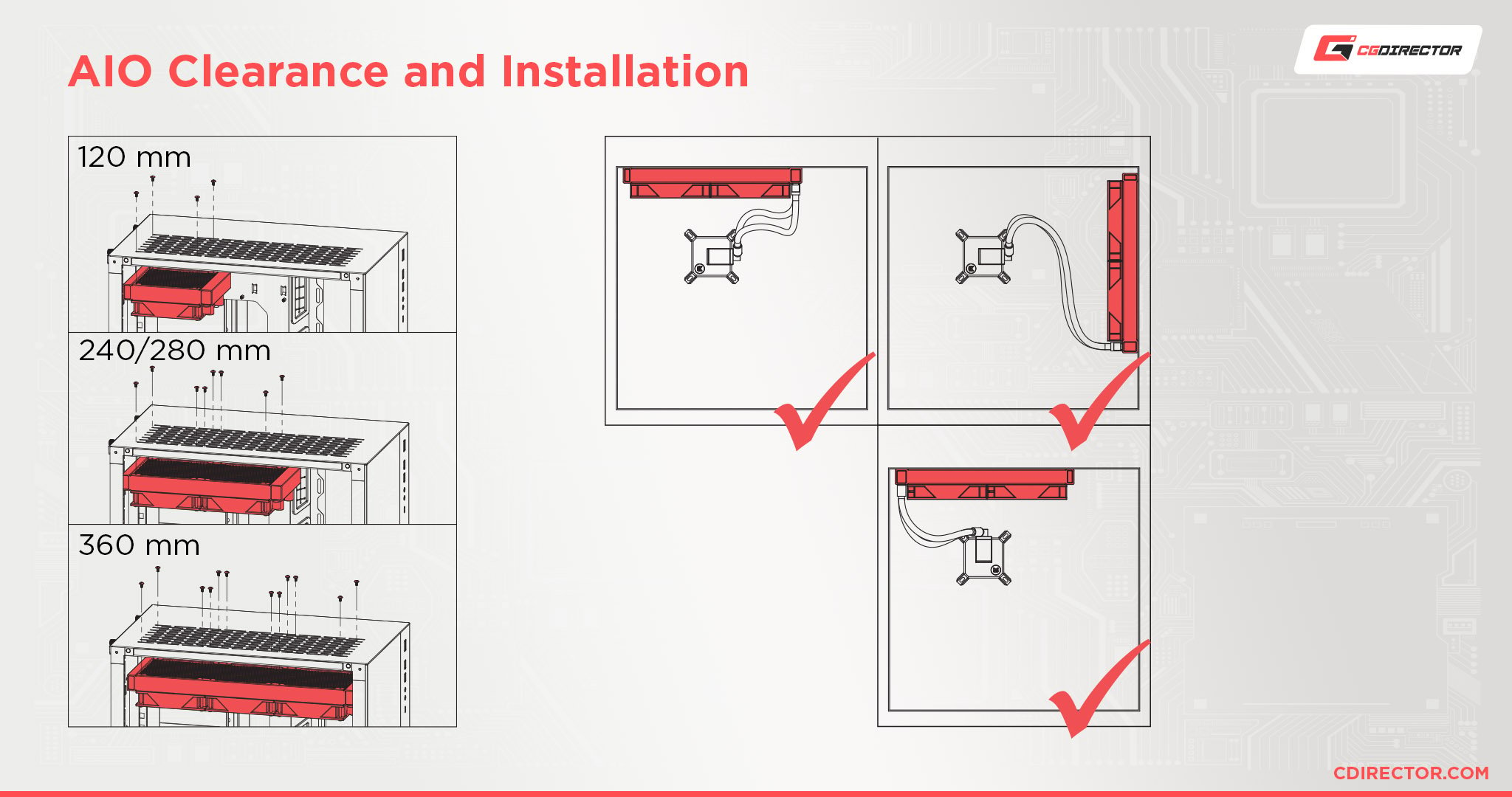
This also allows for compatibility with a broader variety of cases and motherboards, an absence of clearance issues for RAM and PCIe slots, and a more aesthetically pleasing PC interior.
Transportation
An All-in-one Liquid CPU Cooler puts less weight on the CPU and motherboard as the bulk of its weight (radiator + fans) is mounted directly to the case.
So, when you transport your PC, there’s a better chance of avoiding damage to your motherboard or CPU in the process compared to PCs using heavy Air Coolers mounted directly on the CPU.
Air Distribution
When AIOs are mounted in an exhaust configuration (e.g., at the top), hot air is blown out of the case directly, whereas, with air coolers, hot air is blown into the cabinet that case fans will then exhaust.
When mounted in an intake configuration (e.g., at the front), the fans on the AIO function as case fans, pulling in more air without the need for additional case fans.
Of course, this air will already be heated up by the AIO’s radiator and will need to be managed by your case’s airflow.
Disadvantages
Price
If we consider price to performance ratios, the AIO liquid cooler falls significantly behind regular CPU Air coolers.
AIO coolers are far more expensive to manufacture because it has more moving parts, liquids that need to be introduced into the loop and sealed, and tubing that has to be tested for any leakage.
Higher Noise Emissions
Fans mounted on the radiator of the AIO cooler don’t need to spin nearly as fast as the fan of an HSF cooler, so they will naturally make less noise (though this depends on the size and model of the fans and radiator).
However, having multiple fans working together with the AIO cooler’s pump means that even some of the more “quiet” liquid AIO options, like the Corsair H115i Platinum, can reach noise levels close to 50 dB.
The pump is always active, making AIO Coolers louder, especially at idle or light workloads, even when the fans aren’t spinning.
Prone to a Variety of Faults
Unlike many HSF CPU coolers, which only have a single active fan, a liquid AIO cooler has several moving parts that make it more prone to wear and tear.
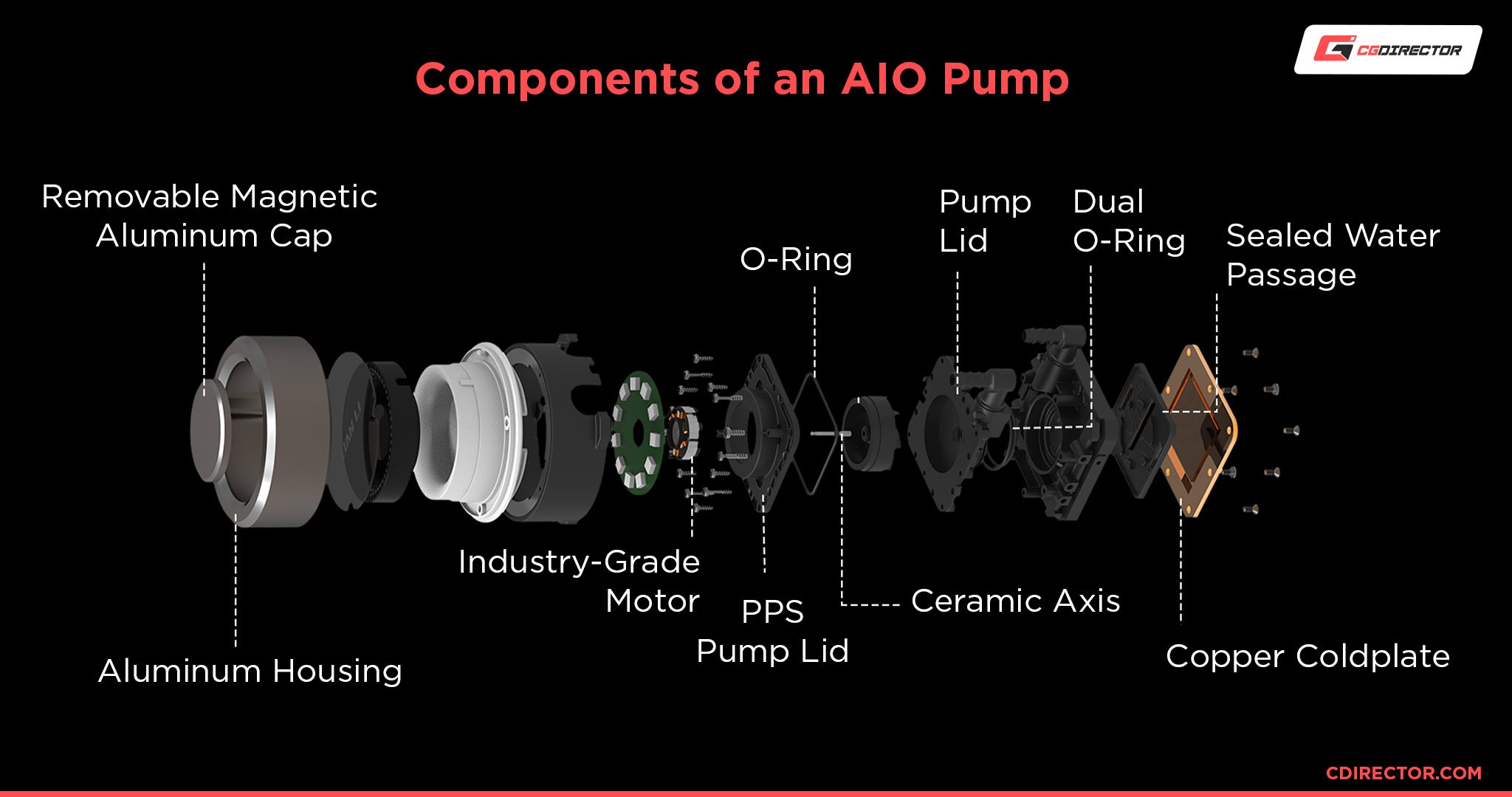
And the more such factors you have to deal with, the higher the chances of encountering an issue.
The radiator can leak, the block can clog, the inner PTFE (Teflon) coating of the tubing can crack, you can encounter liquid permeation and more.
Any of these issues can be incredibly disruptive for any PC. There’s also the paranoia of introducing liquid into what’s basically an electrical system. A leak could be disastrous as it can easily short out your motherboard and/or graphics card, among other things.
Of course, AIOs wouldn’t be as popular as they are if such issues were common.
Faults and disasters like these are rare, but still found more frequently in AIOs than in Air Coolers.
Air vs. AIO CPU Coolers – Which Should You choose?
With a better understanding of what HSF and liquid AIO coolers are, together with their inherent (dis-)advantages, let’s look at what other factors can determine the best option for your PC.
Can AIOs and Air Coolers be compared?
There is no definite answer to whether an AIO or HSF cooler is better as there are so many different factors at play.
It’s a bit like comparing a sofa to an armchair. They’re both pieces of seating furniture, but how do you compare them? Is the armchair better because it fits into tight space, or the sofa because it can seat more people? It depends.
AIO and Air CPU Coolers are much the same.
They’re both meant to cool a CPU, and both have fans and some kind of metal that dissipates heat, but that’s where the similarities end.
To truly be able to compare them to each other and declare AIO or Air the better Cooling System, we would have to:
- Equalize their noise levels
- Equalize their Radiator Mass
- Equalize their Cold Plate Surface
- Equalize their Price
- Equalize their dimensions
- -… etc.
If we equalize the price, we’ll end up comparing a very high-end air cooler to a low-end AIO. Not exactly a fair comparison unless you’re comparing at a specific price point (in this case, an air cooler usually wins. Hands down).
Equalizing Radiator Mass, again, would never show the true potential of high-end AIOs.
We can’t compare them directly; we can only list general observations of tendencies.
And that’s what we’ll do here:
What Kind of Workloads Will Your PC Be Running?
Workloads can generally be categorized into two main types: active and passive.
Active tasks need immediate responses after an action from you, and passive ones are sustained processes that are usually multi-threaded and utilize a CPU’s cores to their full potential.
Active Workloads
Active workloads require fast single-core CPU clock speeds and benefit from automatic boost technologies like Intel’s Turbo Boost Technology and AMD’s Precision Boost Overdrive.
These automatic overclocking algorithms release performance in bursts, boosting only when the CPU truly needs an instant dose of power. However, a CPU can’t sustain this type of boost for too long.
If you primarily process active workloads – like 3D modeling, video editing, motion design, or even gaming – then you’ll need a CPU cooler that can efficiently handle these sudden temperature spikes.
The best type of coolers for active tasks is of the HSF variety.
This is due to the thermal conductivity of the copper heatpipes in combination with the smaller amounts of liquid within that can absorb heat at a rapid pace.
When the boost clock is deactivated, a CPU usually reverts to its lower base clock speeds, providing ample opportunity for the liquid within the heatpipes to condense and return to its original position.
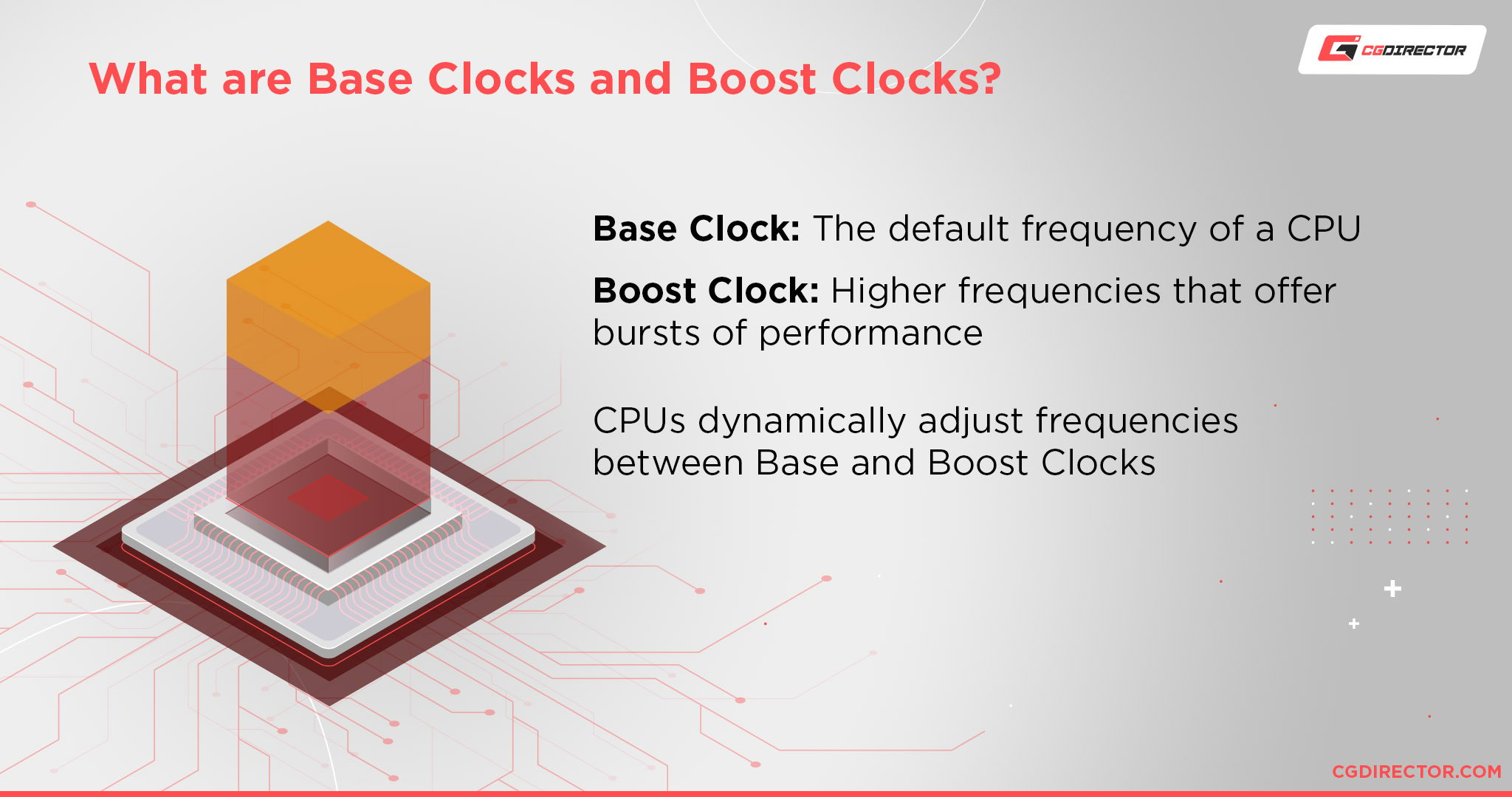
Passive Workloads
Passive workloads benefit from multi-core CPUs and high base clock speeds.
Here, you’ll have a high TDP but aren’t required to accommodate sudden temperature spikes. However, you do need to sustain clock speeds as high as possible for extended periods.
Passive workloads and all-core CPU utilization also benefit from larger Radiator masses and more fans.
Large AIOs tend to keep the CPU a few degrees cooler than Air Coolers under sustained workloads.
If you’re looking to install a CPU cooler in a rendering workstation, then a large 360mm or 420mm liquid AIO cooler is the way to go.
It can keep your CPU chilled during long and sustained workloads. This is due to the amount of heat the liquid coolant can absorb before being pumped into the radiator. There’s also the fresh, chilled liquid that can then be re-introduced into the cold plate – making the cooling process more effective.
What’s Your Budget?
Though the general rule of thumb is that liquid AIO CPU coolers are more expensive than their HSF counterparts, there are cases where they can be equally matched in terms of price.
That said, if you’re looking to get the best performance for each dollar spent, you can’t go wrong with an HSF cooler.
For example, take the dual tower, dual fan Scythe Fuma 2. This air CPU cooler rivals some of the best AIO coolers in OC benchmarks and only costs $60.
What Type of Case Do You Have?
The size of your case will also influence which CPU cooler you should choose.
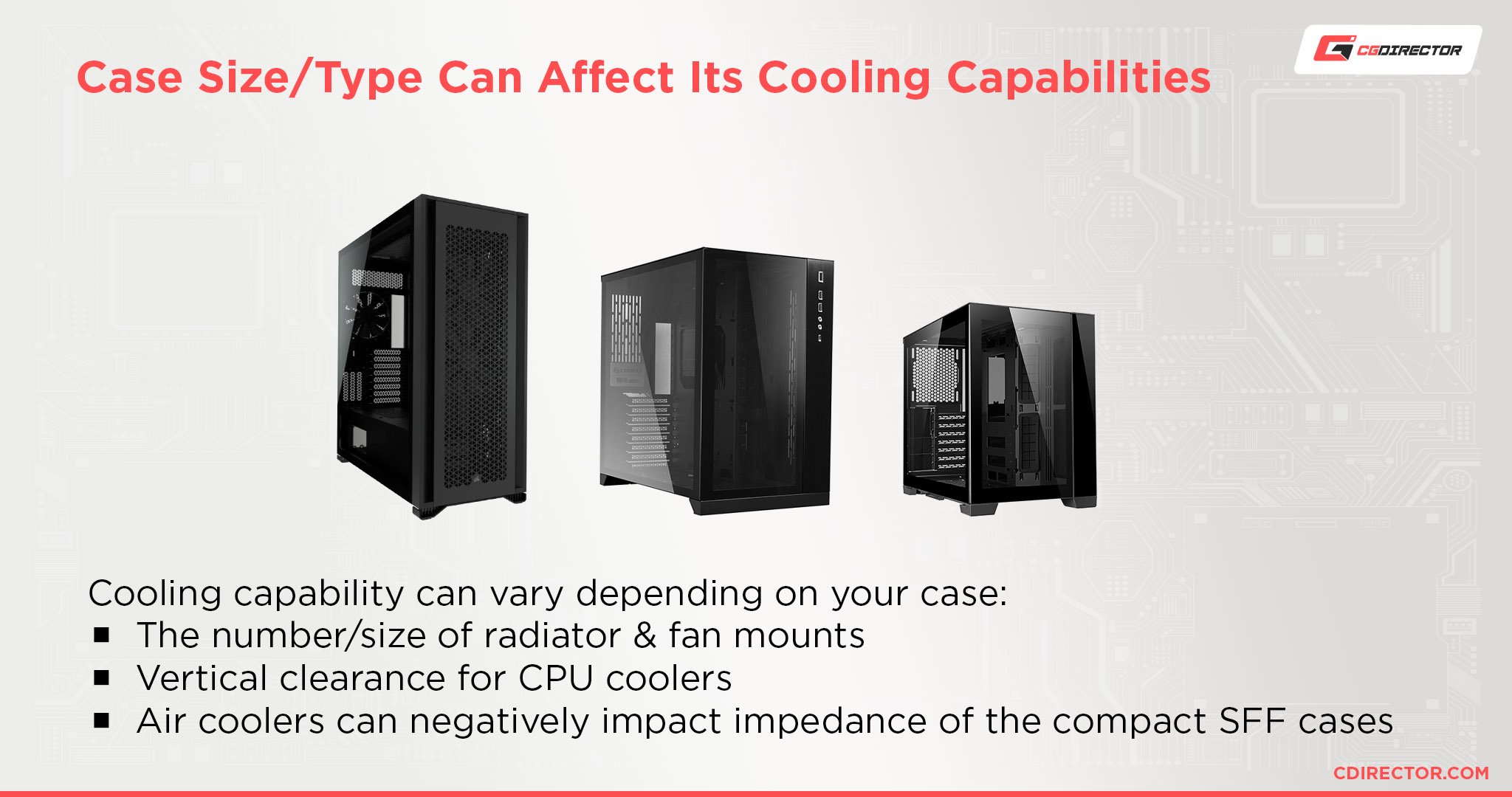
Although there are some small AIOs, for Small Form Factor PC Builds, an Air Cooler that is either very compact or even low-profile will usually outperform its smaller liquid AIO counterpart.
It’s also important to note that some larger HSF models (like the NH-D15S) do squeeze into smaller cases (like the Fractal Design Define Nano S).
Conclusion
In today’s – somewhat oversaturated – CPU cooler market, you can find a plethora of both AIO and HSF CPU cooler options to fit your needs.
No matter what your budget, case size, or cooling needs look like, there’s an option for pretty much every use-case out there.
Air coolers handle burst workloads well, while AIOs are great for sustained workloads.
AIOs are prone to wear and tear, and Air Coolers can last decades.
AIOs can be noisier at idle (pump-noise), so they might not be your go-to-choice for low-noise builds, but they can be less noisy when under full load, thanks to their potentially higher radiator mass, the number of fans, and fan sizes.
Because of the higher manufacturing cost of AIOs, I recommend the following:
- Get an Air Cooler if your budget is below ~80$, as Air coolers tend to outperform AIOs in lower price-tiers.
- If you’re shopping in higher price tiers, grab a high-end AIO (360-420mm) for the best sustained performance.
Over To You
Hopefully, by this point in the article, you already have an idea about the type of CPU cooler that best fits into your own unique setup.
If you’re still on the fence and need some more insight, feel free to ask us in the comments below. You can also check other peoples’ setups and ask for advice in our expert forum.
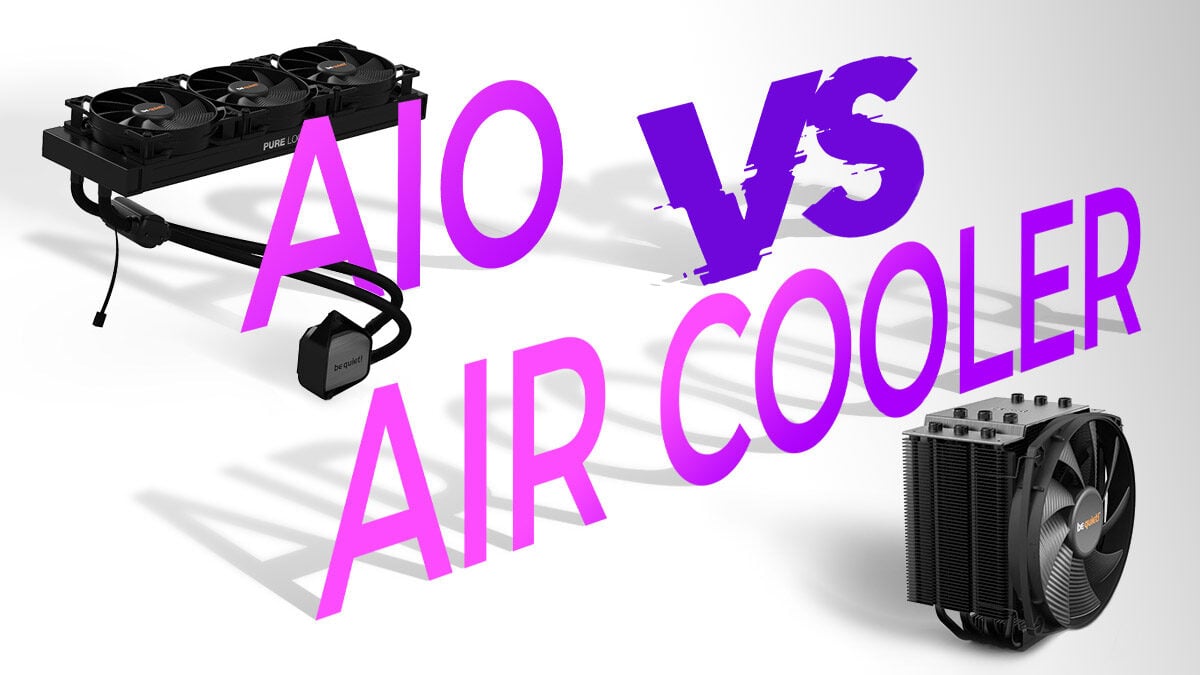
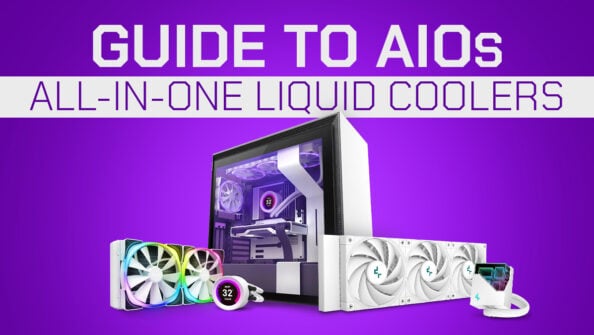
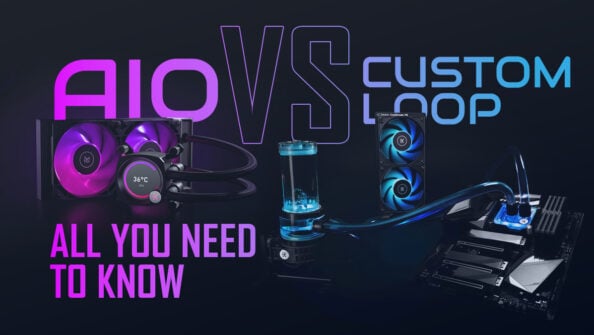
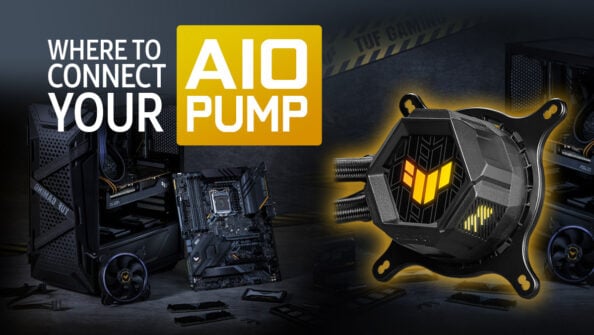
![How to Get a CPU Cooler off of a CPU [Un-stick Glued-On Cooler] How to Get a CPU Cooler off of a CPU [Un-stick Glued-On Cooler]](https://www.cgdirector.com/wp-content/uploads/media/2024/03/How-to-get-CPU-Cooler-off-CPU-Twitter-copy-594x335.jpg)

8 Comments
6 December, 2024
This site is goated because yall write about computer hardware in a way that isn’t explicitly catered to gamers like basically everyone else does, THANK YOU!
17 October, 2023
which cooler would you choose for a Ryzen 9 5900x for rendering .. Noctua NH d-15 or fractal Design Celcius +s28
7 November, 2023
The Air Cooler is better for burst-workloads (single-core), the AIO is usually better for sustained workloads. So if you’re mostly doing CPU Rendering on this PC, the AIO would be the way to go.
27 April, 2023
Hi great article, But I wanna ask can I disable AIO cooler i.e. (without tinkering with any hardware i.e. with the help of software or something else) when I am not doing PC intensive task or when watching videos to reduce noise levels.
Thanks in Advance.
18 November, 2022
Alex,
I’m planning on using a Deepcool AK620 with a i7-13700K in a Fractal Meshify 2 RGB case with a ASUS TUF Gaming RTX 3060-TI. This is going to be a 1440 gaming / light workstation / development machine. Do you think the Deepcool AK620 can handle it? I’m not sure how doing much CPU overclocking I will do, but I will be definitely be overclocking the GPU. In next year or so, I will probably upgrade the GPU and do more overclocking the CPU, but I will still stick with 1440 gaming.
14 December, 2022
Yes, it should be able to handle the 13700k. It’s cooling performance is almost on par with the likes of bequiet dark rock pro 4, and that’s saying something.
Cheers,
Alex
24 October, 2021
Hi alex,
Deepcool AK620
This cooler can handle amd 5950X?
Deepcool AK620 TDP?
25 October, 2021
Yes it’ll work fine for the 5950X. The Deepcool AK620 is even rated for LGA1200 Intel type CPUs, which have much higher TDP than AMD’s current mainstream line-up, so you should see good performance.
Cheers,
Alex